Three years after losing more than 50 pounds, Brad Maren was in the best shape of his adult life. He was strength training four times a week for about an hour, following a program of “high-density” circuit workouts in which he increased weight and reps without changing the workout duration. The program was intense but responsible.
Then one day, in the middle of a set of deadlifts, while pulling the loaded bar from the floor, Maren (name changed, at his request) felt it: a shooting pain where his right glute and hamstring meet. He quickly dropped the weight.
Searching online, the 37-year-old pinpointed the pain to where the proximal hamstring tendon attaches to the ischial tuberosity, or sit bone, at the bottom of the pelvis. Known as high-hamstring tendinopathy, it’s a common strain among athletes and avid exercisers that’s exacerbated by a muscle imbalance between the hamstrings and quadriceps, a lack of flexibility, and repetitive motions.
Maren learned that stretching could help counteract the intense loads he was putting on his body, but he resisted the go-to suggestion on everyone’s lips: yoga. The stereo-typical yoga-class environment — quiet and dimly lit, the scent of essential oils wafting in the air, nimble practitioners bending like Gumby — simply didn’t appeal to him. Moreover, as a Twin Cities–area police officer and busy dad to two young kids, he didn’t have an extra 90 minutes to spare “just” to loosen his tight hamstrings.
Then he discovered ROMWOD — an acronym for Range of Motion Workout of the Day — an online video service based on the principles of martial arts and yin yoga, a slow-paced form of restorative yoga that employs long holds in singular poses to stretch the deeper tissues of the body. Designed for CrossFitters, the daily videos average 17 minutes in length and are filmed in gyms with weightlifters.
“It’s more accessible for athletes who often [resist] typical yoga classes,” says yogi Daniel Head, cocreator of ROMWOD and founder of the Yoga Room in Redlands, Calif.
Maren began following the program, squeezing in the brief sessions each night after his kids were in bed. Within a couple of weeks, he saw improvements in his range of motion and strength, as well as a shift in mindset about how he was approaching his training.
Even better, his hamstring pain subsided almost immediately; a little more than a month later, it was gone. “I can do heavy deadlifts, squats, and other lifts and have no discomfort,” he says.
“Now I have more confidence in the movements, and I trust my body can handle the heavy loads.”
Why Yoga Works
Yoga has long been lauded for benefits that include stress reduction, mental focus, and reduced back pain, among many others. No matter the style, a consistent yoga practice has been shown to contribute to improvements in strength, mobility, balance, and concentration. It amps up physiological and cognitive abilities that translate to better performance. As a result, experts who are adapting yoga for athletes argue that it has a lot to offer people who repeatedly push their bodies to the edge.
“Strength without flexibility equals rigidity, and flexibility without strength equals instability,” explains Jonny Kest, international director of Life Time’s LifePower Teacher Training program (and this month’s cover subject). “You clearly need both for longevity and performance in any athletic effort.”
Yoga is, in many respects, a moving meditation, connecting body and mind through movement and breathing techniques. As it has been embraced by more athletes, there has been renewed interest in studying — and promoting — its physical side. While this doesn’t always accurately describe what yoga is traditionally about, it does home in on the fact that it is good for the body.
Research shows, for instance, that passive stretching — the kind done in yoga — increases the amount of energy stored in muscles and improves their function while also boosting flexibility and balance.
In a recent study published in the International Journal of Yoga, Division II male soccer and baseball players were split into two groups: One took hourlong yoga classes twice a week for 10 weeks, in addition to the normal practice and training for their sports; the other didn’t participate in yoga. At the end of the trial, the yoga group showed significant improvements in flexibility, joint range of motion, and balance. Specifically, these athletes experienced greater dorsiflexion in their ankles, improved knee and hip extension, and better shoulder flexion.
While research on yoga for athletes — and programs adapting it for them — often focuses on the physiological benefits, it’s worth noting that yoga’s mental rewards are also a boon to the athletically inclined. These support performance (increased focus and an improved ability to handle the mental and emotional demands of a tough training day and competition), as well as recovery (stress relief and relaxation).
“This is time for your body to recover, your mind to rest, and to really allow the benefits of exercise to soak in,” says Head.
Moreover, Kest notes, “if you’re relaxed, you’re less likely to choke, and that gives you an advantage in any competitive field.”
None of this is lost on professional athletes whose careers depend on staying in top form. In the past decade, teams such as the Los Angeles Clippers and Seattle Seahawks have hired yoga teachers to work with their basketball and football players, respectively. Meanwhile, tennis pros and U.S. Olympic skiers tout yoga as the secret ingredient for keeping them flexible, balanced, and focused. As yoga has become mainstream among pro athletes, it’s also become more accessible to recreational athletes who don’t consider themselves yogis.
The Yoga Advantage
An estimated 36 million Americans engage in some form of yoga, and there’s increasing interest in using the ancient practice as a performance aid and recovery tool. Given the stress placed on the body by many sports and activities — be it strength training, running, cycling, swimming, tennis and other racket sports, or simply long jaunts on the elliptical — yoga is a logical add-on to many fitness regimens. Repeating the motions commonly associated with a specific activity helps you get better, but it also causes repetitive wear and tear that can lead to niggling discomfort or, over time, injury.
“The body is engineered for balance,” says Erin Taylor, author of Hit Reset: Revolutionary Yoga for Athletes and creator of a program that prescribes short, focused yoga routines designed specifically to address imbalances in the body. “There’s no denying that sports cause imbalance, because they require repetitive movements, often in just one range of motion. Over time, unless you’re doing some cross-training to move the body in different ranges of motion, [you’re] going to injure yourself.”
Yoga can also relieve chronic pain. Dean Pohlman, who created the online training program Man Flow Yoga, has gained a following among formerly athletic guys in their 50s — many who suffer from lower-back pain — looking to get back into shape. Yoga helps address the symptoms of too much time spent sitting at a computer, in the car, or on the couch.
The Man Flow Yoga solution blends brief sequences of slow and controlled yoga poses with sound fitness-training principles. “You don’t have to be a committed yogi to get results,” Pohlman explains.
He says his athletes respond well to receiving practical information about how yoga affects their bodies: increased flexibility, improved muscle recovery, greater range of motion, increased power, a stronger spine, better balance, and reduced risk of injury, to name a few of his top points.
“We talk about how yoga helps with physical aspects that your regular training doesn’t address,” he adds. “Yoga is basically going to make you better at anything you do.”
The specific style of yoga that fitness experts prefer varies. Yin yoga, which is the foundation for the ROMWOD model and one of the fastest-growing yoga-class offerings at Life Time’s clubs, works well for athletes, thanks to slow breathing and long holds that calm the nervous system and soothe the mind and body.
Faster-paced vinyasa classes might be good for those who have trouble slowing down, because it eases them into yoga with a more active feel. Even adding in a couple of poses before or after a workout can go a long way in activating muscles and relaxing connective tissues. (For more on selecting a yoga style, see “Getting Started” on below.)
There is a commonly cited rule that you should spend as much time stretching as you do strengthening. The reality, experts say, is that something is always better than nothing.
Whatever your yoga style of choice, the goals are the same: feel good, perform better, and become more resilient. To achieve this, yoga teachers focus on tailoring poses to achieve balance and improve body mechanics.
Yoga, Taylor says, can be “super-potent preventive medicine.”
There’s Pose for That!
Running
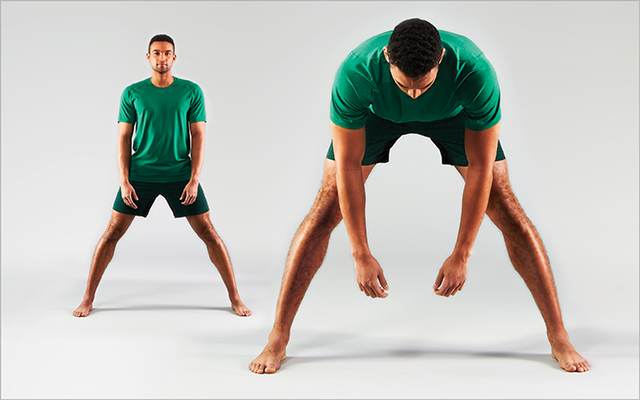 Images by Kelly Loverud
Images by Kelly LoverudWeak and tight hamstrings are common among runners, who often rely on their quads to power themselves forward. (The same is often true for cyclists.) This pose focuses on the adductor magnus, the most powerful adductor muscle, to alleviate tightness, prevent hamstring injuries, and make it easier to activate the glutes.
Pose: Standing Straddle Forward Fold
When to perform: Postworkout or during recovery.
How to do it:
- Step your feet wide apart (about a leg’s length), with your feet parallel.
- Walk your hands down your legs, and allow your torso to hang between your legs. You can bend your knees and rest your hands on the floor or a yoga block, if you choose.
- Bend and stretch your legs a few times, and press down evenly through the bottoms of your feet to gently deepen the stretch. Then be still, and hold for five breaths.
Note: You can also perform this pose with feet turned inward about 30 degrees, internally rotating at the hips to deepen the stretch.
Strength Training
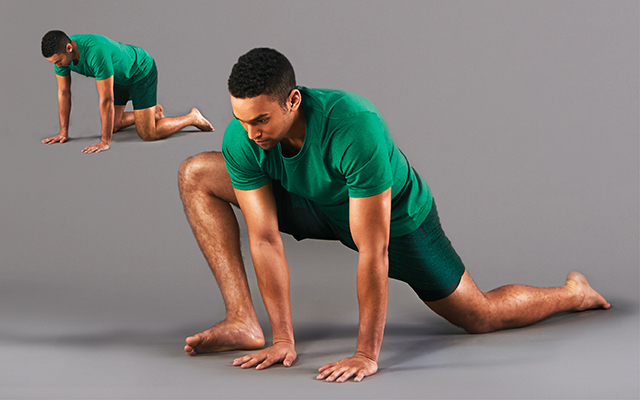 Images by Kelly Loverud
Images by Kelly LoverudDue to thicker fascia in the lower body, not to mention bigger muscles and bones, the legs need more attention in preparation for and to recover from moves like squats and deadlifts. This pose will hit the quads, groin, hip flexors, hamstrings, glutes, and IT band.
Pose: Lizard
When to perform: As part of your warm-up and cool-down, or any time on rest days.
How to do it:
- Start on your hands and knees, and step the right foot outside your hands. Tip the foot on its outside edge if possible.
- Slide your left leg back behind you (if needed, place a blanket or towel under the left knee).
- With your hands or forearms on the floor (use a block or pillow if reaching the floor is too intense), let your back round and your head hang naturally.
- Relax your lower body, inhaling for eight seconds and exhaling for 10 seconds. Work up to holding for two to four minutes.
- Repeat with the opposite leg.
Basketball
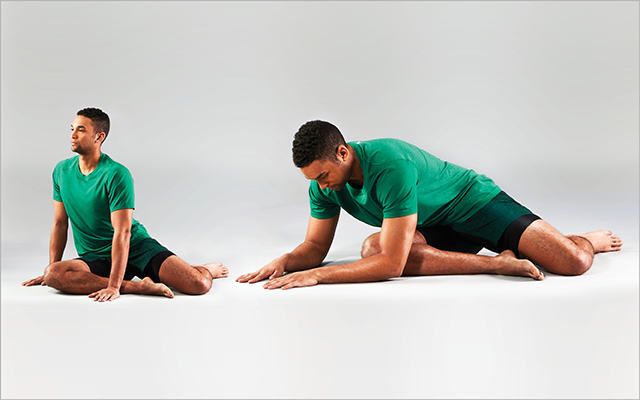
Target Area: Glutes and hips
Athletes who rely on fast-twitch muscle action (think short, explosive movements) worry about losing power by overstretching. But when connective tissue is tight and dry, those muscles suffer. When your fast-twitch muscles aren’t getting proper circulation, you lose some of your explosive potential. This post-workout move improves blood flow to these areas.
Pose: Pinwheel
When to perform: Postworkout or during recovery.
How to do it:
- Sit on a mat and bend your knees, staggering one leg in front of the other in a pinwheel shape.
- Keeping both feet flexed, sit up tall and turn your torso toward your front thigh, and then fold over it, propping yourself up on your forearms. Use a block or pillow for added support, if needed.
- Hold for five to eight breaths, unwind from the pose, and then switch the direction of your legs.
- Repeat on the other side.
Cycling
Target Area: Chest
Sitting, especially for long periods, can have deleterious consequences on posture — whether you’re hunched over in your office chair or in the saddle of your road or stationary bike. Over time, this position can cause tightness and foreshortening of the chest muscles, making it hard to engage the core and potentially causing back and neck pain. This move will help open up the chest and counteract tightness.
Pose: Chest Expansion
When to perform: Postworkout or during recovery.
How to do it:
- Standing, clasp your hands behind your back, interlacing your fingers.
- Move your shoulder blades closer together by squeezing your elbows toward each other. Feel your chest opening.
- Looking straight ahead, keep your face and neck relaxed, and hold for five to eight breaths.
Tennis
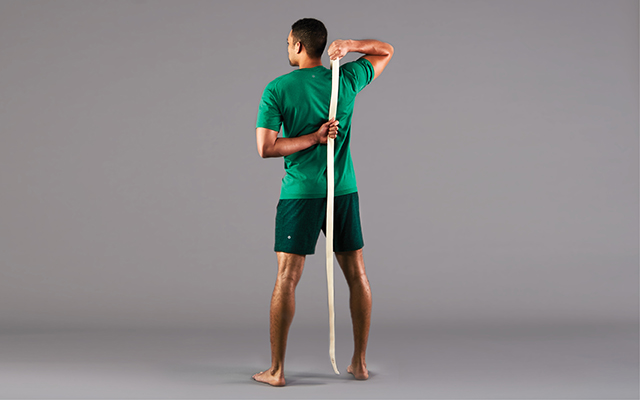 Images by Kelly Loverud
Images by Kelly LoverudServing a ball places tremendous force on the area where the four muscles of your rotator cuff connect your arm to your shoulder blade. The best way to avoid injury to this area is to learn to coordinate the movement of your shoulder blade and upper arm’s ball-and-socket joint. This stretch will also help.
Pose: Rotator-Cuff Stretch
When to perform: Postworkout or during recovery.
How to do it:
- Hold a yoga strap, towel, or rolled-up T-shirt in one hand. Lift your arm straight up, palm facing behind you, and bend the elbow so that the strap hangs down your back.
- Reach your other hand behind you to grab the strap from the bottom, with that elbow pointing toward the ground.
- Pull down on the strap to deepen the stretch in the back of your top arm. Engage your core to avoid rounding your back.
- Hold for up to eight breaths, and then switch sides.
Swimming
 Images by Kelly Loverud
Images by Kelly LoverudSwim strokes primarily rely on strength, mobility, and power in the upper body. These muscles tend to be smaller than lower-body muscles and often need additional TLC to work well and feel good.
Pose: Shower
When to perform: Postworkout or during recovery.
How to do it:
- Face a wall and put both hands on it about an arm’s distance above your shoulders, fingers pointing up.
- Step away from the wall and lengthen your spine toward the floor. Engage your core and lift your ribs so you don’t collapse into your spine.
- Keep your head in a neutral position by gazing at the point where the wall and floor meet, and hold for five to eight breaths.
Getting Started
If you’re committed to your fitness but have been intimidated by yoga, these tips can help you find a practice that’s right for you.
• Look for classes that specify yoga for athletes. Yin, restorative, and gentle yoga are great for recovery, while vinyasa’s faster pace and strength focus can be a useful cross-training option. (To learn more about the different types of yoga, check out “Yoga 4 You“.)
• Search for sport-specific classes. Many studios offer classes designed for a particular sport, such as running. Beginner-level classes are approachable for less flexible, more muscular bodies.
• Find a certified instructor. Many personal trainers are teaching yoga to their clients, but not all of them are certified. If your trainer is not, you can decline his or her yoga-inspired teachings if you feel uncomfortable.



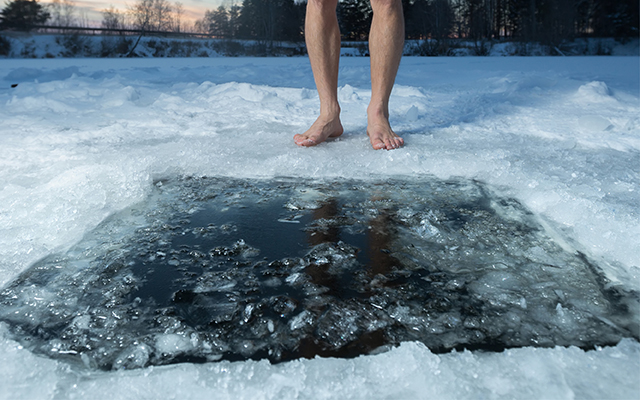
This Post Has 0 Comments